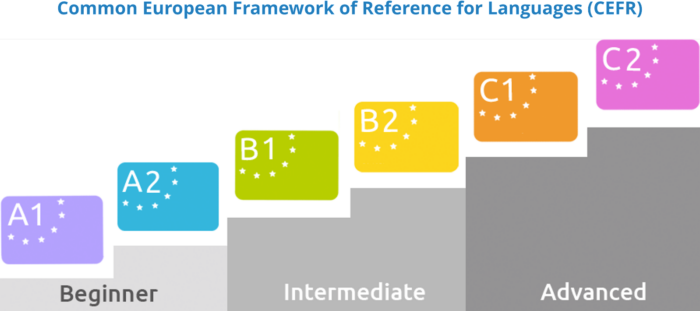Factors Affecting How Quickly You Learn A Language
Read other articles:
Back to posts
Table of Contents

You might not like the answer to the question of how long it takes to learn a foreign language.
Why?
Because it depends.
It depends on who you ask; it depends on the language; it depends on how many hours per day/week you put in; it depends on whether you’re learning your first, second or third foreign language; it depends on the methods you use; and it depends on what level you’re aiming to achieve.
There are so many variables with language learning that definitive answers are difficult — though everyone wants to hear one.
Let’s say you’re aiming for near-native-level fluency with a language. Most students with this goal will know they need to work hard to achieve it. They’ll put the hours in and research the best methods or know them already, giving them a head start. They could reach a fair level of proficiency in a few hundred hours (which could be as little as a few months), be more fluent in a few hundred more and reach an advanced level within a year. True fluency may take another year or more, though.
Others will take three or four times as long as this — or never get there.
Because of the many variables, we need to go deeper into how long it takes to reach a good level of fluency with a foreign language and how you may be able to accelerate the time it takes.
- Language learning levels: A quick overview
- Timescales for learning a foreign language: Who says what?
- The main factors affecting how quickly you learn
- How can you accelerate your language learning?
Language learning levels: A quick overview
When investigating how to learn a foreign language, you’ll hear outlandish claims like “learn a foreign language in 20 hours” or “native-speaker level in 3 months”.
Be wary of time specifications used as “hooks” to pull learners into a particular app or enroll in a particular course. It makes no sense to estimate timescales for learning a language unless we first understand the various levels to aim for.
To make things simple, language learning proficiency levels are usually divided into three:
- Beginner level
- Intermediate level
- Advanced level
There’s also something called the Common European Framework Reference (CEFR), which helps us break it down further.

From the most basic to the most advanced, we have A1, A2, B1, B2, C1 and C2. Let’s take a closer look…
Beginner level (A1/A2)
At the beginner level, you can manage basic conversations in the target language and “survive” using the vocabulary learned.
It will take most people a few months to reach this level and be confident enough to start using what they’ve learned but more adept and diligent students can get there quicker.
If the language is very different from your native tongue and a new “type” of language that you’ve never learned before, it may take longer than average. For instance, if a native English speaker is trying to learn Japanese, it might take them longer than a Chinese student who is already familiar with a similar writing system.
Intermediate level (B1/B2)
At the intermediate level with a language, students can conduct more meaningful interactions with other speakers and start to read texts or use the language for business purposes.
B1 level is at least a step above the holiday level and allows you to start to delve deeper into the language and culture. B2 is approaching a more advanced level.
Reaching an intermediate level usually takes up to a year or more.
Advanced level (C1/C2)
When you reach an advanced level with a foreign language, you can interact more confidently with native speakers and understand more sophisticated content in social and business interactions.
This usually takes several years and mastering the finer points of a language may take even longer.
C2 level is often called “native-speaker-level” proficiency and it should be what most people reading this are aiming for.
Timescales for learning a foreign language: Who says what?

If you want to learn a language to an advanced level, you’re aiming well beyond the standard level that most casual students reach. But how long that takes depends on who you ask.
The CEFR produces quite a useful estimate because it’s broken down into beginner, intermediate and advanced levels. It also includes different estimates for different types of languages (Romance, Germanic, Slavic and East Asian):
| Language Family | Languages Include | Hours to Beginner | Hours to Intermediate | Hours to Advanced |
|---|---|---|---|---|
| Romance | Spanish, French, Italian, Portuguese, Romanian | 70-200+ | 300-600+ | 700-1000+ |
| Germanic | German, Dutch, Swedish, English | 80-250+ | 350-650+ | 800-1100+ |
| Slavic | Russian, Polish, Ukrainian, Czech | 100-300+ | 500-800+ | 900-1800+ |
| East Asian | Chinese, Japanese, Korean | 100-500+ | 800-1700+ | 2200-2500+ |
The range used by the CEFT is 70 to 2500 hours plus! So, now you see the problem of answering the question of how long it takes to learn a foreign language.
We’ll go deeper into the factors that affect these estimates in the next section but let’s take a quick look at what some other sources say about the time to learn a language.
The US Foreign Service Institute (part of the State Department) claims that it takes 600-2200 hours to learn a language to a high level of proficiency, depending on the category of language (easy to difficult). The FSI has decades of experience in teaching languages to U.S. diplomats intensively.
2,200 hours would be over 40 hours a week, so unless you were learning the language full-time for a year (eight hours a day five days a week), achieving a high level within a year would be virtually impossible.
Conversely, achieving a high level in 600 hours (with an easier language) at 30 hours a week would only take 20 weeks — so simpler languages could be learned to a high level in 5-6 months, according to the FSI.
I think it’s fair to say that most people will take two years or more to learn most languages to a high level.
Language expert Stephen Krashen says that it takes several years to reach fluency in a second language and “advanced fluency” will take five to ten years.
The British Council provides the following estimates for reaching CEFR levels with their English-learning programs:
- A1: No estimate as it’s the starting point
- A2: Approximately 180 – 200 hours
- B1: Approximately 350 – 400 hours
- B2: Approximately 500 – 600 hours
- C1: Approximately 700 – 800 hours
- C2: Approximately 1,000 – 1,200 hours
Finally, applied linguist Paul Pimsleur said that a person who desires “balanced competence” could acquire “reasonable mastery” by studying six hours per week for two years (625 hours).
The main factors affecting how quickly you learn
We’ve already covered the target language levels (beginner, intermediate and advanced). Besides the level you’re aiming to reach, the following are the three main factors that affect how long it takes to learn a language:
1. The type of language you’re learning

We already know that some languages are classified as more difficult to learn than others. The following classifications from the CEFR may be useful (note that English falls into the second category):
- Romance languages
Examples: Spanish, French, Portuguese, Italian
Time to reach a highly advanced level: 1,000+ hours
- Germanic languages
Examples: English, German, Dutch, Swedish
Time to reach a highly advanced level: 1,100+ hours
- Slavic languages
Examples: Russian, Polish, Czech
Time to reach a high advanced level: 1,800+ hours
- East Asian languages
Examples: Chinese, Japanese, Korean
Time to reach a highly advanced level: 2,500+ hours
2. How hard you study (motivation)

Casual learners may pick up a language for an hour or two per week and never aspire to get beyond a beginner or intermediate stage of proficiency.
With a highly motivated student, who intends to get to an advanced level (perhaps for a specific purpose like employment or living overseas) and works consistently to achieve his/her goals, the time investment could be anywhere from 5-7 hours up to 20 hours or more per week.
The level of commitment, motivation and study ethic will greatly influence how long it takes to learn a foreign language. Immersive learning, where you surround yourself with the target language, generally gets quicker results.
Your learning methods

There are many methods for learning a foreign language and they don’t all get equal results.
Even if you’re fortunate enough to have unlimited access to a personal tutor, the method used to teach you will depend on the approach and the skills of the teacher. It doesn’t guarantee success.
Self-study is generally considered an inferior, slower approach to learning a language. However, it depends on the method employed and the resources used. If you are highly motivated and can immerse yourself in the language by self-study, your learning can be more effective than a traditional approach in a classroom or with a tutor.
Many apps have cropped up to help language learners with self-study but, in truth, language apps don’t always work. Many rely on the traditional grammar-translation method of learning a language, which may get you to a certain basic level but won’t usually help you achieve much higher.
It’s important to get instruction in the native language from the start, exposing you to the target language. The most effective method of learning is full immersion in your target language. If you can’t work or study abroad to make this happen, then you can use the technology and available resources to achieve the next best thing…
How can you accelerate your language learning?
If you want to master a foreign language fluently, video is the next best thing to “being there”.
With the rise of artificial intelligence and a huge library of captioned video content from around the world, there are so many possibilities to learn a language on YouTube, Netflix or other video platforms.To find out more about ramping up your language learning through video, download our free Chrome extension and start accelerating your journey toward your language goals.
Read other articles:
Back to posts
